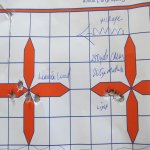Over the winter I bought a chronograph that can be paired to a smartphone. I decided to take out the Pro Chrono for the first time today because my missus wanted to go to the club property to do some photography. I've used a chronograph in the past, but rarely use my phone, and since my wife is quite familiar with them I thought her presence might be helpful to me. It was also very calm this morning, and it still is as I type.
I did some shooting sans chronograph while my better half took pictures. When she finished I set up the chrony. Once the phone was turned on and the app opened, it paired immediately. As a preliminary test, I shot a over half a box of ammo over the chrony with my 1411. The thing worked as it should. For my more serious test, I used a box of Center X from two years ago. It isn't a very consistent lot, but I was more interested in how what appeared on the target related to what the chronograph said.
Over 50 rounds, the average MV was 1034 fps, the ES was 39 fps, and the SD was 8 fps. No surprises there.
On the target, however, there wasn't always an obvious relationship between POI and MV. Below is the target shot with the CX. While many groups are cringeworthy, groups 2 - 7 (each row shot left to right, top first) were much better than I remembered about the performance of this ammo. Those six groups averaged just under .270".
More important and significant to me, however, was what the apparent incongruity between what the chronograph told me and where some of the rounds impacted on the target. I've appended some notes on the target.
On the first group (top, left side) the shot with the lowest POI had the highest MV of the five shot group. On the ninth group (second from right side, bottom row) the shot with the highest POI had the lowest MV of the group.
To be sure, the further the target the target the more MV variation should be seen on targets. At the distance this target was shot (57 yards), a difference of 10 fps between two rounds should result in a vertical spread of about 0.1". At 100 yards, similar rounds with the MVs I had today would have about .29" of vertical spread.
I understand that one target and one set of chronograph data is a limited amount of data. I thought it was curious, however, that the conventional wisdom that rounds with a higher MV will strike the target at a higher POI than those with a significantly slower MV. It suggests, but clearly not prove, that there's more to ammo behaviour than MV.

I did some shooting sans chronograph while my better half took pictures. When she finished I set up the chrony. Once the phone was turned on and the app opened, it paired immediately. As a preliminary test, I shot a over half a box of ammo over the chrony with my 1411. The thing worked as it should. For my more serious test, I used a box of Center X from two years ago. It isn't a very consistent lot, but I was more interested in how what appeared on the target related to what the chronograph said.
Over 50 rounds, the average MV was 1034 fps, the ES was 39 fps, and the SD was 8 fps. No surprises there.
On the target, however, there wasn't always an obvious relationship between POI and MV. Below is the target shot with the CX. While many groups are cringeworthy, groups 2 - 7 (each row shot left to right, top first) were much better than I remembered about the performance of this ammo. Those six groups averaged just under .270".
More important and significant to me, however, was what the apparent incongruity between what the chronograph told me and where some of the rounds impacted on the target. I've appended some notes on the target.
On the first group (top, left side) the shot with the lowest POI had the highest MV of the five shot group. On the ninth group (second from right side, bottom row) the shot with the highest POI had the lowest MV of the group.
To be sure, the further the target the target the more MV variation should be seen on targets. At the distance this target was shot (57 yards), a difference of 10 fps between two rounds should result in a vertical spread of about 0.1". At 100 yards, similar rounds with the MVs I had today would have about .29" of vertical spread.
I understand that one target and one set of chronograph data is a limited amount of data. I thought it was curious, however, that the conventional wisdom that rounds with a higher MV will strike the target at a higher POI than those with a significantly slower MV. It suggests, but clearly not prove, that there's more to ammo behaviour than MV.










































































